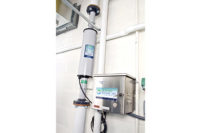Service technicians often confuse motor horsepower (hp) with tons of refrigeration. One common misconception is that 1 ton of refrigeration equals 1 hp. This statement is only true in some of the higher-temperature applications, such as air conditioning. In medium- and low-temperature refrigeration applications, 1 hp is hardly ever equal to 1 ton of refrigeration. Let’s review a few principles to illustrate this point.
A Rate, Not an Amount
First, a ton of refrigeration is a rate of heat transfer, not an amount. One ton is equal to the heat absorbed in melting 2,000 pounds (1 ton) of ice at 32°F in 24 hours (one day). This equates to 12,000 Btuh.
Equation No. 1
(2,000 pounds) x (144 Btu per pound) ÷ (24 hours) = 12,000 Btuh
Equation No. 1 mathematically proves how 1 ton of cooling equates to 12,000 Btuh. Note: 144 Btu per pound is the latent heat of fusion for ice. This means that 144 Btu are absorbed for each pound of ice that is melted to water.
When refrigeration or air conditioning equipment is rated for 1 ton of cooling, it means the equipment should remove heat at a rate of 12,000 Btuh. If the equipment is removing 12,000 Btu in 2 hours, for some reason, then its capacity is only 1/2 ton. Or, if the equipment is removing 12,000 Btu in 4 hours, its capacity is only 1/4 ton. Notice, in all three scenarios, 12,000 Btu were removed; the time rate of how fast these systems removed the 12,000 Btu determined the capacity of the system’s tonnage.
A Service Scenario
The following is a service scenario of a system having a low capacity and not being able to keep the proper freezer temperatures.
At a local supermarket, customers have been complaining for three weeks of warm products in a low-temperature, glass door, reach-in freezer incorporating R-404A as the refrigerant. The store owner inspects the thermometers in the case and notices the temperature will not pull down below 15°F. The temperature has been 15° for about a week, but should, ideally, be 0°. The store owner then proceeds downstairs where the condensing unit is located. The compressor seems to have a constant run time. After about 10 hours of constant run time with a warming product load, the store owner decides a service technician should be called in to remedy the problem.
The service technician arrives and talks to the store owner about the problem.
The service technician enters the basement and notices the condensing unit is a 3-hp, semi-hermetic reciprocating compressor with a forced-air condenser. The system also has a thermostatic expansion valve (TXV) and a receiver. The temperature in the basement is 70°.
The technician installs gauges on the low and high side of the compressor and takes an amp reading. The pressure on the low side is 33.5 psig (0°); on the high side the reading is 174 psig (80°). The amp reading is 5 A under the rated load amps (RLA) on the name plate. The service technician then places a temperature probe on the condenser and evaporator outlets in order to get a condenser subcooling and an evaporator superheat reading, respectively.
The condenser outlet temperature is 71°, and the evaporator outlet temperature is 14°. This gives the system 9° of condenser subcooling and 14° of evaporator superheat, as shown below in Equations No. 2 and 3.
Equation No. 2
(Condensing temp.) — (Condensing outlet temp.) = Condenser subcooling
80° — 71° = 9°
Equation No. 3
(Evaporator outlet temp.) — (Evaporator temp.) = Evaporator superheat
14° — 0° = 14°
In summary, the system check was:
Evaporating temp......0° (33.5 psig)
Condensing temp......80° (174 psig)
Condenser split......10°
Condenser subcooling.....9°
Evaporator superheat.....14°
Basement ambient.....70°
The technician realizes the unit cannot be low on refrigerant, because the 9° of condenser subcooling tells him there is liquid in the condenser. Also, evaporator superheat is usually much higher on systems low on charge. After thinking a moment, the technician wonders why the condensing temperature is only 10° hotter than the ambient or the surrounding temperature in the basement. This is an indication the condenser is not rejecting very much heat from the system to the basement air. The difference in temperature between the condenser temperature and the ambient air is often called the “condensing split,” and it should run from 25°-30° on standard condensers in this age range under normal heat loads.
The technician analyzes the system check again. A dirty condenser would give a high condensing temperature and pressure. A dirty evaporator would give a low evaporating temperature and pressure. If the liquid line or metering device was restricted, the evaporating temperature and pressure would be low. The technician wonders what would cause a high evaporating temperature (pressure) and low condensing temperature (pressure) with a low amp draw. The technician then realizes the compressor’s valves or piston rings could be worn and leaking. This would cause leakage of pressure between the high and low sides of the system as the pistons reciprocated, causing a lower condensing pressure with a higher evaporating pressure. The amp draw also would be low because of pressure leakage within the cylinders and/or valves. This also would give the system low capacity and the inability to pull down to the proper freezing temperatures.
The technician pumps the compressor down and examines the valves and valve plate. Sure enough, the valves are not seating properly and are warped. A new set of valves with gaskets for the valve plate and head are installed. The compressor is evacuated and put into commission. After about one hour of running time, the system pulls down to 0°. A new system check is taken and everything seems to be running properly. Both the condensing pressure and evaporating pressure are normal. Since the compressor was 17 years old, the technician blames the valve problem on old age and wear and tear since no obvious system or mechanical problems existed. The technician then explains his actions to the store owner.
Here is the new system check:
Evaporating temp......-16 (20 psig)
Condensing temp......96° (222 psig)
Condenser subcooling.....8°
Evaporator superheat.....7°
Condenser split:.....26°
Basement ambient:.....70°
The customer is happy, his customers are happy, and the technician can pride himself on a job well done.
Publication date: 5/4/2015
Want more HVAC industry news and information? Join The NEWS on Facebook, Twitter, and LinkedIn today!









